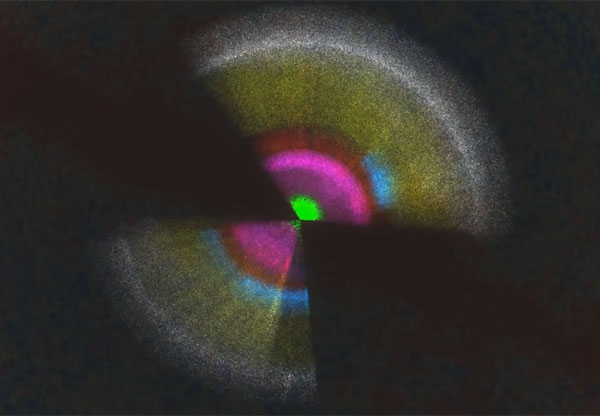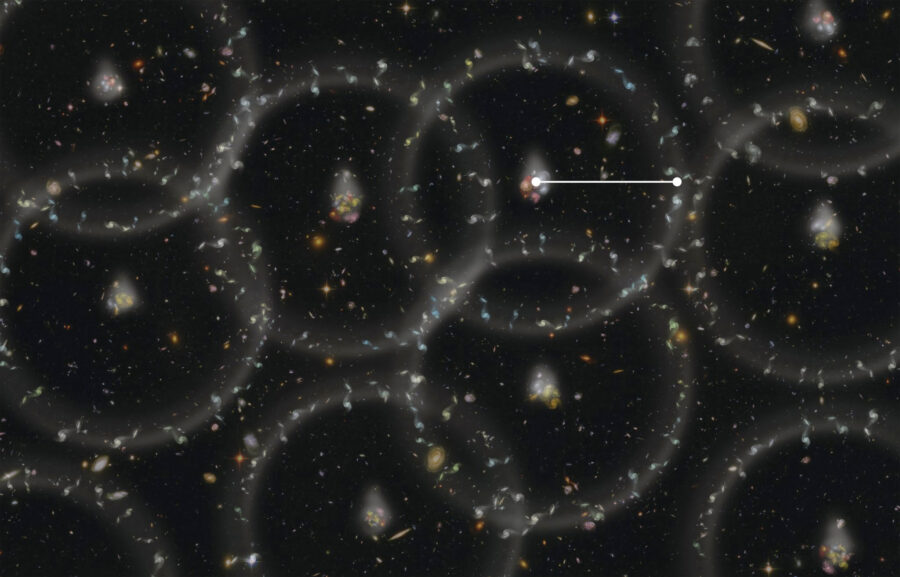The Sloan Digital Sky Survey has released a new map of the universe — and the results confirm ongoing tension over the expansion rate of the universe.

A. Raichoor (EPFL) / A. Ross (Ohio State Univ.) / SDSS Collaboration
The Sloan Digital Sky Survey (SDSS) project has been scanning the sky for the past 20 years, collecting spectra of millions of galaxies. Now, the SDSS has released a culmination of that data collection: a comprehensive look at the universe’s evolution over the past 11 billion years.
In a gaggle of 23 papers released on the arXiv astronomy preprint server, astronomers amass conclusions from the larger SDSS survey, specifically from its Extended Baryon Oscillation Spectroscopic Survey (EBOSS), which catalogued almost 1 million spectra of galaxies and quasars in a search for a signature from the universe’s earliest years.
Waves in the Primordial Sea

Zosia Rostomian / Lawrence Berkeley NationalLaboratory)
In the early universe, light and matter were entangled in each other, so that as charged particles moved, photons did too. And move they did: as plasma gravitated toward areas of higher density, photons rebelled, pushing the charged particles outward again. The resulting push and pull set the primordial plasma sloshing.
As the cosmos cooled, ions were finally able to hold on to their electron partners in a moment termed recombination, some 380,000 years after the Big Bang. Since this recombined matter was no longer charged, it separated from light. Freed photons flashed out in what we now call the cosmic microwave background (CMB), bearing the tiny energy fluctuations that reflect the variations in density present at that time. Likewise, while the primordial sloshing stopped with recombination, it had left its imprint on the distribution of matter.
Gradually, atoms combined into dust and stars and galaxies, but the imprint remained on the very largest cosmic scales. Galaxies naturally gravitate into groups and clusters. But when SDSS astronomers looked on a grander scale, tabulating the distances between thousands of galaxies, they found a pattern: Galaxies are slightly more likely to be separated by 490,000 light-years from their nearest neighbor.
Filling the Gap
That was in 2005. This is now: Astronomers on the EBOSS team have upped the ante, looking at millions of galaxies and quasars rather than thousands. Not only do they see the same characteristic separation, a “standard ruler” that can be used to gauge the cosmic expansion rate, they have measured that ruler over cosmic time to see if it has changed.
As astronomers look out into the universe, they’re staring back in time. To map the nearby universe out to 6 billion years’ travel time, they collected spectra of large, red galaxies. Farther out, they observed younger, blue galaxies. Finally, to map 11 billion years into the past, they looked to quasars, where material falling onto a central supermassive black hole lights up and outshines its whole galaxy.
“The EBOSS results are the culmination of a massive effort, and result in a superb map of the universe,” says Wendy Freedman (University of Chicago), who was not involved in the study.
The massive amounts of data collected for the EBOSS project fills in part of a huge gap between observations of supernovae or variable stars in relatively nearby galaxies and the distant cosmic microwave background, emitted 13.4 billion years ago.
Increasing Tension
One of the most striking results from the EBOSS survey is a new measurement of the Hubble constant, a number that reveals how fast the universe is expanding now. This number has famously been the subject of debate ever since it was first measured; currently, most measurements of the early universe, such as the density fluctuations of the CMB, show the number to be on the lower side, while measurements in nearer galaxies give a higher number.
The EBOSS team is taking a side in the fight. Estimating a Hubble constant value between 67.4 and 69.0 km/s/Mpc, the team has results on the level of the measurements from the CMB.
“Taken together, detailed analyses of the EBOSS map and the earlier SDSS experiments have now provided the most accurate expansion history measurements over the widest-ever range of cosmic time,” says EBOSS survey scientist Will Percival (University of Waterloo, Canada) in a press release.
While it might seem esoteric, the exact value of the Hubble constant decides the fate of the universe. And the fact that different methods attain different values suggests that there might be some unknown physics happening — something that would cheer physicists who have spent decades trying to directly detect dark matter and understand the true nature of dark energy.
“If people thought that after more data collecting the discrepancy would just disappear, that hasn’t happened,” says Adam Riess (Johns Hopkins University), who also was not involved in the study. “In fact, its significance has generally been growing.”
Riess and Freedman, who have both run studies based on stars in nearby galaxies, agree that the fact that the discrepancy persists strengthens the tensions between methods that use faraway light to sample the early universe and methods using nearby objects to sample later on in the cosmic timeline. “I think there is something interesting at play,” Riess muses.
“The baryon acoustic oscillation measurements are further important because they provide information on how the universe has evolved with time, and constraints on how, for example, the dark energy has evolved with time,” Freedman explains. Indeed, EBOSS measurements show that dark energy hasn’t changed a whit — which actually eliminates one possible explanation for the Hubble constant discrepancy.
Freedman also notes that the disagreement over the Hubble constant depends to some extent on what methods are used. She herself has done studies using Cepheid variable stars and red giant stars, which give two different results.
“I think we still don't know how this issue will be resolved,” she adds. “It is an interesting time in cosmology.”
 5
5









Comments
Rod
July 22, 2020 at 8:51 am
I enjoyed this report. Here are some observations from me on the topic. The S& T report stated, "The massive amounts of data collected for the EBOSS project fills in a huge gap between observations of supernovae or variable stars in relatively nearby galaxies and the distant cosmic microwave background, emitted 13.4 billion years ago." I checked this reference, NASA ADS Abstract, 'The Completed SDSS-IV Extended Baryon Oscillation Spectroscopic Survey: Growth rate of structure measurement from cosmic voids', https://ui.adsabs.harvard.edu/abs/2020arXiv200709013A/abstract, July 2020. The arxiv report is attached in this record. The redshift range surveyed is, "eBOSS conducted a 5-year observation program, surveying the large scale structure of the Universe over a redshift range from 0.6 to 3.5." The S&T report stated, "Extended Baryon Oscillation Spectroscopic Survey (EBOSS), which catalogued more than 4 million spectra of galaxies and quasars in a search for a signature from the universe’s earliest years." Using this cosmology calculator, http://www.astro.ucla.edu/~wright/CosmoCalc.html, shows look back time or light-time for z=3.5, 11.897E+9 LY distance, flat universe parameter and defaults. Redshift or z=0.6, light-time or look back time distance is 5.773E+9 LY. The nearly 4 million or so targets surveyed thus range from 5.773E+9 LY to 11.897E+9 LY look back time in BB cosmology. Rounded, 6E+9 to 12E+9 light-years look back time or light-time distance. The Hubble time using z = 67.4 is 14.168E+9 years ago. Using z=69, Hubble time is 13.84E+9 years ago. There is 3.28E+8 years time difference (delta) between these two values for the Hubble time that could change much in the BB cosmology for BB cosmology timelines, e.g. origin of the CMBR and earlier conditions, e.g. inflation. Other values for H0 range up to 82 km/s/Mpc.
You must be logged in to post a comment.
Peter Wilson
July 22, 2020 at 2:52 pm
Here we go again.
"While it might seem esoteric, the exact value of the Hubble constant decides the fate of the universe."
No; it does not. At least, not alone. The fate of the universe hangs upon multiple factors, most of which the Standard Model ignores, because they make they math fiendishly difficult. The Standard Model is a “spherical cow” approximation of the universe. It only takes into account density and expansion-rate. The equations represent a mathematical ideal: a perfectly smooth, uniformly expanding, ideal gas. Nothing like what we see.
Can we get a more realistic model of the universe? A model that includes star and galaxy formation?
Dark Energy Dialogue: https://youtu.be/4goInwbOix4
You must be logged in to post a comment.
Rod
July 23, 2020 at 12:14 pm
Peter Wilson, it is Rod 🙂 I watched the 29 minute video at your link provided. Interesting discussion about *eta* vs. *lambda* and what may be the cause of expansion of space. Lambda is the cosmological constant in Einstein GR, originally it could be zero, +, or - value (i.e. a free parameter). Alan Guth today (Scientific American), shows lambda used as repulsive gravity during inflation and 3D space expands > 1E+20 c. I noted too the discussion in the video on why the Moon is expanding away from Earth, something normally discussed in the context of Newtonian tidal dissipation parameter and conservation of angular momentum and Earth rotation rate slowing down. I did enjoy the 29 minute discussion, some fun in it too 🙂
You must be logged in to post a comment.
Peter Wilson
July 30, 2020 at 8:39 am
Thanks! I don't see any way forward, except to add some complexity to the model: eta, etc.
You must be logged in to post a comment.
Andrew James
August 28, 2020 at 8:20 pm
"While it might seem esoteric, the exact value of the Hubble constant decides the fate of the universe."
No; it does not.
Right. It decides the AGE of the Universe, which in turn, tell us the evolution star and galaxy formation.
The Universe is not infinitely old nor infinite in size, no matter how much you wish it to be. General Relativity has been experimentally proven correct. Fact.
As for "The equations represent a mathematical ideal: a perfectly smooth, uniformly expanding, ideal gas. Nothing like what we see." is just wrong. Just looking at the fluctuations in the cosmic background or the distribution of galaxies says otherwise. I have yet to see any theory that says the early Universe was an ideal gas. Quantum physics says otherwise.
Furthermore, observations shows the Universe is expanding (direct evidence), which theory quantifies by the Hubble Constant. The bigger question is where, when and how the energy came from to make the Universe in the first place.
You must be logged in to post a comment.
You must be logged in to post a comment.